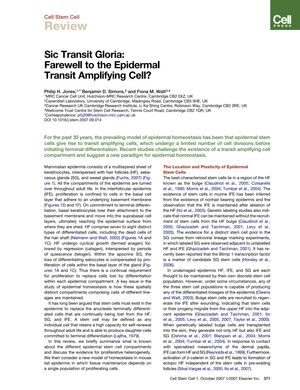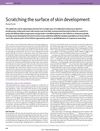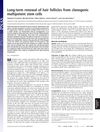Sic Transit Gloria: Farewell to the Epidermal Transit Amplifying Cell?
October 2007
in “
Cell Stem Cell
”

TLDR New research suggests that skin cell renewal may not require a special type of cell previously thought to be essential.
In the 2007 document, the traditional model of epidermal homeostasis, which posits a hierarchy of epidermal stem cells giving rise to transit amplifying (TA) cells, is challenged by new research. The review discusses the potential for a single population of proliferating cells to maintain tissue homeostasis, with a focus on the plasticity and location of epidermal stem cells in the hair follicle, interfollicular epidermis, and sebaceous glands. It also critiques the epidermal proliferative unit (EPU) model and the use of label-retaining cells (LRC) to identify stem and TA cells, suggesting that the epidermal cell population is more complex and heterogeneous than previously thought. A study using the AhcreER transgenic mouse line for lineage tracing over a year revealed that clonal evolution in the interfollicular mouse tail epidermis is governed by a single rate-limiting process, with proliferating basal cells adopting one of three fates at random, which challenges the stem/TA cell model and proposes that homeostasis can be maintained without quiescent stem cells entering the cycle.
View this study on cell.com →
Cited in this study
5 / results
research Wnt-dependent de novo hair follicle regeneration in adult mouse skin after wounding
Hair follicles can regrow in wounded adult mouse skin using a process like embryo development.

research Scratching the surface of skin development
The document concludes that skin stem cells are important for hair growth and wound healing, and could be used in regenerative medicine.

research Long-term renewal of hair follicles from clonogenic multipotent stem cells
Adult stem cells from rat whisker follicles can regenerate hair follicles and sebaceous glands.
research Morphogenesis and Renewal of Hair Follicles from Adult Multipotent Stem Cells
Adult mouse skin contains stem cells that can create new hair, skin, and oil glands.
research Involvement of Follicular Stem Cells in Forming Not Only the Follicle but Also the Epidermis
Hair follicle stem cells can form both hair follicles and skin.